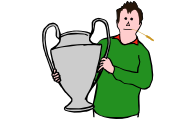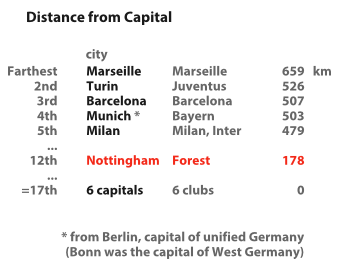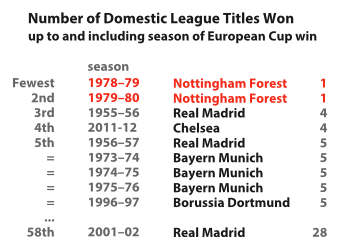Just how provincial were Brian Clough’s Nottingham Forest?

The best manager England never had, he won the league with two unfancied provincial clubs, Derby County and Nottingham Forest, and won the European Cup in successive seasons with Forest
Joe Lovejoy, Glory, Goals and Greed: Twenty Years of the Premier League
Brian Clough astonished the football world when he made an unfashionable, modest provincial club the champions of Europe in two successive seasons
Robert Galvin, The Football Hall of Fame
Derby and Forest were not merely provincial sides without a league win to their names, but neither was even in the First Division when Clough took over
Jonathan Wilson, Nobody Ever Says Thank You
Brian Clough and Peter Taylor were reunited… They took over a small provincial club, Nottingham Forest… Going on to win the European Cup in 1979 and… again in 1980.
Epilogue of the film adaptation of The Damned United
The adjective ‘provincial’ is regularly used to describe Nottingham Forest, particularly by those emphasizing the achievement of Brian Clough guiding them to consecutive European Cup triumphs. Its name certainly alludes to the countryside but is the club really significantly more provincial than many of the other champions of Europe?
The two attributes that seemed obvious to me in measuring a settlement’s provinciality are size – the smaller the settlement the more provincial it is – and distance from its national capital – the greater the distance the more provincial it is. If the characteristics of the team itself are relevant as well as the town or city where it plays its home matches, having a recent history of finishing in the depths in a domestic league and lacking titles make decent indicators of lack of success, or footballing ‘smallness’ if you will, which you would expect to be a result of being based in the provinces.
I have presented those metrics below for the winners of each of the 58 seasons of the European Cup and Champions League. There are a couple of caveats to the population data I’ve used. Firstly, consistent historical figures for city populations are not easy to come by so I’ve used modern populations instead of the value at the time of each win. The usefulness of this substitution relies on the assumption that the cities in question have grown at similar rates over the last six decades. Secondly, deciding where a city begins and ends is tricky. The chart shows both the population of the cities proper and the population of its ‘larger urban zone’, a term defined by the European Union’s statistics agency. Where a larger urban zone is not given for a city, I’ve used an equivalent measure of ‘urban area’. I don’t know how systematic the larger urban zones measurements were able to be; similar figures from other sources can vary wildly depending on where you draw your boundaries.

Whether you look at city or urban zone, of the settlements that are home to a side that have won the European Cup, Nottingham has fewer residents than all of them except Eindhoven – and PSV have only one title to Forest’s two.

Nottingham is definitely on the provincial side in terms of size but is it really such an outlier? Liverpool, for example, is less than twice its size, a meagre difference considering London is 16.5 and 9 times the size of Liverpool as a city and urban zone respectively. I wouldn’t say Nottingham is smaller than Liverpool to an extent that one is clearly provincial and one clearly isn’t.
When you consider its distance from London, a mere 180km, Nottingham seems practically metropolitan.

There are 11 cities farther from their capital, including Liverpool (and Birmingham and Manchester). Going by size and location, you could argue successful managers of Liverpool deserve a degree of praise for bringing glory to a provincial city but I have never heard anything to that effect. As another example, Porto is quite similar to Nottingham in size and is not particularly close to Lisbon but I don’t recall those facts being part of the story when José Mourinho won the Champions League in 2004.
To counter these examples you could point to the facts that of the 58 competitions, 44 of the winning cities and 46 of the winning urban zones are over twice the size of Nottingham and those shouldn’t be overshadowed by the enormity of London. You might also argue that instead of the error being that Forest get too much credit, it’s that Liverpool or Porto get too little. By presenting the data visually I have tried to help you come to your own conclusions.
Where Nottingham Forest definitely stand out from Liverpool, Porto and every single other winner is in its lack of prior footballing success. Forest had a solitary First Division title in the bag when it won the European Cup in 1979 and hadn’t added to it by 1980 (and is still yet to). No other winner really comes close to that.

Joint second are Real Madrid in 1956 (the very first winners) and Chelsea in 2012 with four domestic league titles each.
Forest are also unique in their prior league positions. Just four years before their debut European Cup win they finished 16th in the Second Division, or 38th in the Football League as a whole, and two years before it they finished 3rd in the Second Division, 25th in the Football League. No one else has ever finished anywhere near that low in the five seasons before their European Cup win. Only one other team on one occasion has ever finished outside the top ten in their equivalent period: Manchester United, who ended the 1962-63 First Division in 19th place (and Aston Villa get an honourable mention for finishing 11th the year they won it). When Brian Clough took over at Nottingham Forest they were 35th in the Football League, and the 38th place finish was their most recent, and in under four and a half years they were champions of the continent, which is without doubt extraordinary.
At that moment of Clough’s arrival Forest were mid table in the second tier, familiar with the bottom half of the first and had had a taste of the third since the war – what you would call a ‘small club’ and also not dissimilar to, say, Fulham at the time. Had he taken Fulham to European success would it really have been any less of an achievement because London is a huge city and Nottingham is a fairly little one?
It is debatable whether Nottingham Forest really are ‘provincial’ to any extent that is significant to winning the European Cup. What is not debatable, with their single First Division title and mud from Second Division pitches barely out of their studs, is that in relative terms they were very unsuccessful. Perhaps the word ‘provincial’ is popular for describing the club because it serves as a sensitive alternative to the potentially contentious, but probably more appropriate, ‘small’.
REFERENCES
City populations: Wolfram Alpha (2004-2011)
Larger urban zone populations: Eurostat (2007-2009) except Belgrade (Wolfram Alpha, 2007), Marseille (Wolfram Alpha, 2007) and Dortmund (Wikipedia)
Distances: Wolfram Alpha

Excellent stats. I wonder – is there a degree to which provincial is assumed when it is isolated geographically from other successful successful clubs, rather than just distance from London? Just a theory – but I wonder whether Liverpool’s proximity to Manchester means that it is seen a new regional centrepoint for which others should be measured.
Might be nonsense of course – but in footballing terms – I wonder whether London should be consider the yardstick.
cheers…nice way to present football stats…in btw check out our football website http://www.soccersouls.com/ it has good articles..
[…] Just how provincial were Brian Clough’s Nottingham Forest? — On Goals Scored “The adjective ‘provincial’ is regularly used to describe Nottingham […]